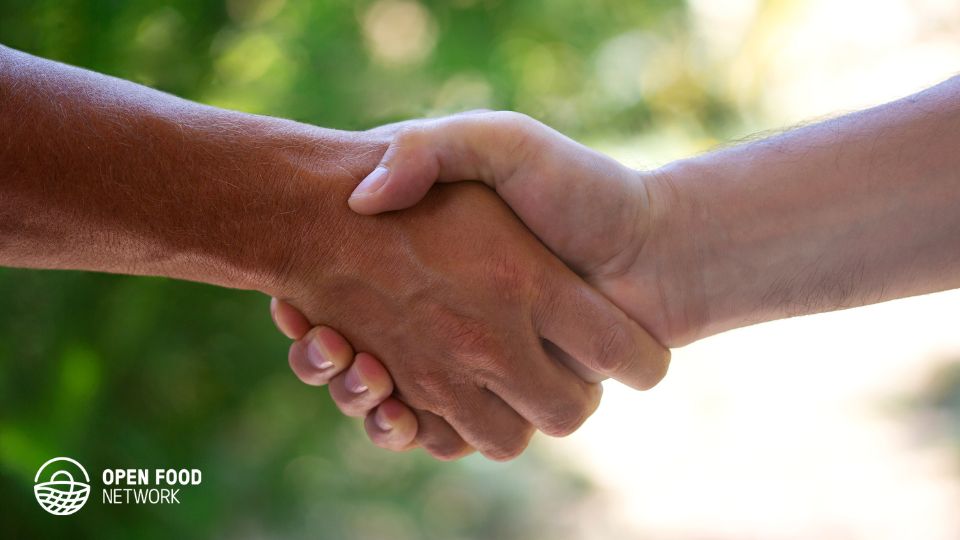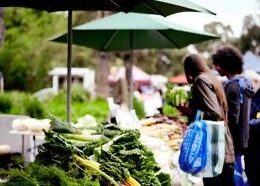Research Report
Strengthening farmer – buyer relationships with governance

Working towards whole crop purchasing for zero on-farm food waste
Through the Whole Crop Purchasing project, Open Food Network has been facilitating connections between Victorian-based farmers and values-aligned buyers, to reduce on-farm food waste and design it out of the system.
A key project aim was to experiment with different models and governance structures in the establishment of ongoing relationships between farmers and values-aligned buyers. We wanted to test how this approach may serve as a mechanism to minimise, or avoid on-farm food waste from occurring.
Whole Crop Purchasing contracts are an approach identified as having huge potential to minimising on-farm food waste. This model is more frequently used by large food retailers and producers. It usually involves a forward supply contract whereby the buyer commits to purchase the entire crop (regardless of the aesthetic or grade), in some cases before the seeds have even been sown in the ground.
One of our assumptions was that strong governance via formalised relationships would provide more certainty for both parties, increased viability and fair prices for farmers, and overall less food waste that contributes to climate change.
How we formalised relationships between farmers and buyers
During the initial stages of the project, our research found that formalising relationships, including forward planning and whole crop purchasing, was not a common practice for the small to medium-sized farmer and buyer participants. Therefore there was a hesitation from both farmers and values-aligned buyers in entering a contractual agreement. In addition to this, the appetite of values-aligned buyers to either financially commit to produce ahead of time or hold more risk (say like in a Community Supported Agriculture model) was very low due to the ongoing impact and uncertainty of Covid-19 on the hospitality, food service and retail sectors.
In response to these factors, a Memorandum of Understanding (MoU)** agreement became the preferred template and approach for project participants to build more formalised relationships.
MoUs outline the intent of the relationship and are often used for legally non-binding purposes. However it is recommended that the agreement always explicitly state that has not been created for legally binding purposes. Similarly, an MoU can have legally binding elements which must be clearly stated within the agreement.
In facilitating the establishment of several formalised relationships, we used a generic MoU template and undertook a co-design process where the agreed needs or requirements of each party were incorporated into each MoU document.
Guide to building an Memorandum of Understanding (MoU) agreement
This section outlines the key elements that can be used as a guide for farmers or values-aligned buyers looking to establish or build stronger relationships.
Types of Schedules incorporated
Key elements of the Memorandum of Understanding (MoU) agreement
Duration of MoU agreement
The project timeframe was used as the endpoint for the MoUs. In some instances caveats were added such as: “or until completion of the 2022 supply”, or, “or until the terms of a forward supply contract if agreed upon by both parties”
Purpose and objectives
High level details of the intent of the relationship between the parties. For example, “Producer X and Buyer Y are committed to maintaining a positive and cooperative working relationship.”
Roles and responsibilities
Specific roles and responsibilities of each party were outlined including communication, participation in the facilitation process that was followed throughout this project, supply and purchase for produce. For example, “Producer X and Buyer Y participate in a facilitated negotiation process to agree on risks and responsibilities in the relationship”
Specifications
Outlining of details: volume, sizing requirements, supply timeframes, logistics, primary contacts, payment and invoicing, notice requirements if order cannot be fulfilled by either party. Pending the type of schedule, the specifications were outlined within a schedule accordingly (see schedules below).
Insurance
Stating any insurances that should be held by each party i.e. WorkCover, Public Liability, Transit etc.
Advertising and announcements
Relating to the permission, negotiation and/or expectations that may be required for each party to announce, circulate or publicly disclose information or reference the relationship. For example, social media posts by Buyer Y that feature Producer X produce must include mention of Producer X social media account.
Confidentiality
Stating of information disclosed between parties (i.e. pricing, customers, staff, business plans, suppliers) is a confidential matter between parties. Written consent required prior to sharing of disclosed information to any third parties.
Dispute resolution
Stating that if a dispute or difference arises in connection to the MoU, a written notice specifying the matter may be made to the other party and that within 7 days of the notice, a meeting is held between each party in good faith with a view to resolving the difference.
Types of schedules incorporated
Standing purchase order
Incorporated when the buyer had established business and secure markets that enabled a consistent need for produce. For example, a standing purchase order of Produce X every 2 weeks, delivered to Address X, invoice emailed with X payment terms.
Phased approach
Adopted when the buyer had established business and secure markets that enabled a consistent need for produce. For example, a standing purchase order of Produce X every 2 weeks, delivered to Address X, invoice emailed with X payment terms.
Preferred supplier
Applied when the producer and buyer were wanting to establish an ongoing relationship however the buyer was unable to commit to a certain amount of produce like in a standing purchase order. For example, Buyer Y exclusively purchases from Producer X, unless in the instance where Producer X are unable to fulfill an order.
Formalising relationships leads to better outcomes for all parties.
Several participating farmers and buyers found MoU agreements to be useful for initial relationship and trust building that works towards ongoing, more formal relationships. It also serves as a reference point with clear documentation of the roles and responsibilities held by each party.
The MoU agreement enabled both parties to navigate the parameters of the relationship and indicate their intent for an ongoing relationship without the weight of legal obligations. This level of documentation offered the right balance and level of commitment for participants. It was used like a ‘trial’ supply arrangement to assess whether they would want to proceed with an ongoing arrangement or contract.
An important limitation with using a non-binding MoU is that this type of agreement does not provide a party with protection if the other party does not act in the spirit of the agreement. Therefore if the level of investment for one party is considerable, it may be worth investigating options for a contractual agreement.
The Whole Crop Purchasing project has been supported by the Victorian Government’s Recycling Victoria Innovation Fund as part of the Circular Economy Business Innovation Centre.
** The MoU template used for the purpose of this project has been put forward as an example of how parties can structure and agree on their expectations for the relationship. This is based on Open Food Network’s experience in participating in similar projects. Open Food Network has not provided any legal advice throughout this project and this article does not intend to provide any legal advice.
Latest Resources
Can we help?
Have an idea, a project or a question? Want help using the Open Food Network software? Get in touch and find out how we can help you with it.
Keep in touch
Join us
Create a listing, shop or group directory on the Open Food Network. Tell me more!

Read our Terms and conditions | Find us on GitHub
Open Food Network is a free and open source software platform. Our content is licensed with CC BY-SA 3.0 and our code with AGPL 3.
We take good care of your data. See our cookies policy
Open Food Network respectfully acknowledges the traditional custodians of the unceded lands on which we meet, work and live. We pay our respects to their Elders, past, present and emerging and acknowledge their deep spiritual relationship to country.




